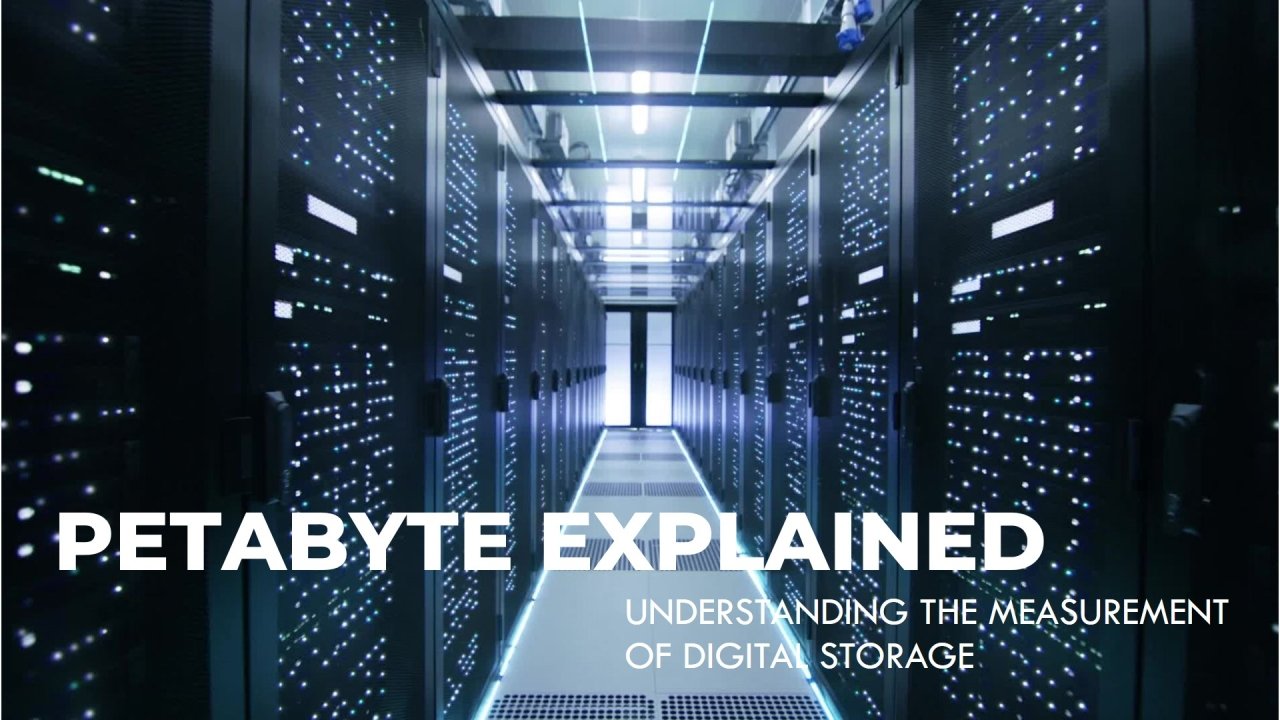In today’s world of big data, terms like “terabytes” and “petabytes” have become essential in understanding the vast scale of information that drives modern technologies. But what exactly is a petabyte, and why is it becoming such a crucial part of our digital infrastructure? A petabyte, equivalent to 1,000 terabytes or 1 million gigabytes, represents an immense volume of data that is increasingly needed to power industries, businesses, and even our personal devices. From cloud storage to AI models, petabytes are the foundation for everything digital, and understanding their significance is vital for anyone interested in the future of technology.
What is a Petabyte?
A petabyte (PB) is a unit of digital information storage that equals 1,024 terabytes or 1,048,576 gigabytes. In simpler terms, a petabyte is an incredibly large amount of data—so large that it can be difficult to conceptualize. To put it into perspective, if you were to store 1 petabyte of data in high-definition video files, you could watch over 200,000 hours of video, or around 23 years of continuous playback. This scale is often required for enterprise-level applications, cloud providers, and even emerging technologies like artificial intelligence and machine learning.
The rise in petabyte-level storage needs is largely driven by the growing consumption and production of digital data. As businesses, governments, and individuals generate more data than ever before, the demand for storage solutions that can handle these massive volumes has skyrocketed. From videos and images to scientific data and medical records, almost every industry relies on the ability to store and process petabytes of data efficiently.
The Growing Need for Petabyte Storage
As the digital landscape continues to expand, so does the need for storage solutions that can accommodate petabytes of data. In industries like healthcare, where patient data, medical records, and imaging systems generate enormous amounts of information daily, storing petabytes of data is no longer a futuristic concept but a present-day necessity. Similarly, scientific research—particularly in fields such as genomics, astronomy, and climate modeling—has led to an exponential increase in data generation, often requiring petabyte-scale storage.
Moreover, in the realm of entertainment and media, streaming platforms like Netflix and YouTube accumulate petabytes of content every day. According to recent studies, Netflix alone stores petabytes of video data across its global network to deliver content to millions of users. As consumers continue to demand higher quality media, such as 4K and 8K video, the amount of data generated only grows larger, thus increasing the demand for efficient petabyte storage solutions.
Petabyte Storage in the Cloud: The Future of Data
Cloud storage has revolutionized the way businesses and individuals manage their data. Leading cloud providers like Amazon Web Services (AWS), Google Cloud, and Microsoft Azure have enabled organizations to store and process petabytes of data without needing to own or maintain the physical infrastructure. By offering scalable storage solutions, these platforms allow users to store massive amounts of data at a fraction of the cost of on-premise hardware.
The beauty of cloud-based petabyte storage lies in its flexibility. Organizations can scale their storage needs up or down as required, only paying for what they use. Cloud storage solutions, therefore, make it possible for even small businesses to tap into petabyte-level storage without making significant upfront investments in expensive hardware. This trend is expected to continue, with analysts predicting that the cloud storage market will continue to grow at an unprecedented pace, as more companies migrate their data to the cloud to take advantage of cost-effectiveness and scalability.
How Petabyte Storage Powers AI and Machine Learning
Artificial Intelligence (AI) and Machine Learning (ML) are among the most data-hungry fields in modern technology. For AI and ML models to be effective, they require vast amounts of data for training, testing, and refining algorithms. Petabytes of data are essential in this process, as these models are trained on massive datasets to learn patterns, make predictions, and automate tasks.
For instance, natural language processing (NLP) models like GPT-3 and GPT-4 rely on petabytes of text data to understand human language and generate responses. Similarly, computer vision models require massive image and video datasets to recognize objects, identify faces, and drive autonomous vehicles. These AI-driven technologies wouldn’t be possible without the availability of petabyte-scale data storage and computing power.
In fact, as AI continues to evolve, the demand for petabyte storage solutions is expected to increase significantly. A report from the International Data Corporation (IDC) predicts that by 2025, the global datasphere will reach 175 zettabytes—more than 175 billion petabytes—highlighting just how much data will be required to fuel future AI advancements.
Expert Insight on Petabyte Storage
“Data storage is the backbone of all emerging technologies,” says Dr. Jane Smith, a leading data scientist and researcher at Stanford University.
“Without robust storage systems capable of handling petabytes of data, we wouldn’t have the computational power required for AI, big data analytics, or even the cloud services we take for granted. The future of technology depends on our ability to store, access, and process data at an unprecedented scale.“
Dr. Smith’s point emphasizes the critical role that petabyte storage plays not only in current technologies but also in enabling future advancements. As we move further into the era of big data, the ability to efficiently manage petabytes of data will become even more integral to technological progress.
Security and Efficiency: The Challenges of Petabyte Storage
While the potential of petabyte storage is vast, there are significant challenges involved. One of the most pressing concerns is data security. With petabytes of data stored across various platforms, ensuring that sensitive information remains protected from cyber threats becomes a top priority. Encryption, data redundancy, and multi-factor authentication are just a few of the strategies employed to safeguard petabyte-scale data.
Another challenge is ensuring data accessibility and efficiency. As the volume of data grows, the need for faster data retrieval and processing becomes more urgent. Efficiently managing petabyte storage systems, especially in the cloud, requires sophisticated algorithms and infrastructure that can quickly retrieve and process data at scale. Innovations in storage technology, such as the development of faster and more reliable hard drives, as well as improvements in software and cloud architecture, are essential to meet these demands.
The Impact of Petabytes on Big Data Analytics
Big data analytics is another area where petabytes play a vital role. The vast amount of data generated by sensors, social media platforms, and Internet of Things (IoT) devices is analyzed using advanced algorithms to derive insights that drive business decisions, policy-making, and scientific discoveries. Petabytes of data are continuously processed, helping organizations and governments forecast trends, predict consumer behavior, and optimize operations.
For instance, in the retail industry, companies analyze petabytes of data from customer transactions, online behavior, and social media interactions to personalize marketing campaigns and improve customer satisfaction. Similarly, in the healthcare sector, petabytes of medical data, including patient records, research studies, and diagnostic imaging, are analyzed to discover new treatments, enhance patient care, and predict disease outbreaks.
Petabytes in the Future: What’s Next?
Looking ahead, petabytes of data will continue to shape the digital landscape. With advancements in quantum computing, it is possible that data storage capacities could grow exponentially, allowing for even larger datasets to be handled and processed more efficiently. As technology continues to evolve, so too will the way we store and manage petabytes of data.
The future of petabyte storage is not just about holding vast amounts of data; it is about enabling innovation across sectors. Whether it’s revolutionizing healthcare with personalized medicine or powering self-driving cars, petabytes are the foundation for the next wave of technological breakthroughs.
Conclusion
In conclusion, petabytes of data are the lifeblood of modern technology, and their importance will only continue to grow as the world becomes increasingly digitized. From powering cloud storage solutions to enabling advancements in artificial intelligence and big data analytics, the impact of petabyte-scale storage is profound and far-reaching. As we continue to push the boundaries of what’s possible in technology, the role of petabytes will remain central to shaping the future.
Understanding the power and potential of petabyte storage helps us appreciate the complex and interconnected systems that support our digital lives. With the ongoing advancements in storage technology and the increasing demand for larger data sets, petabytes will continue to be at the heart of technological innovation, driving progress in every sector of society.


